Graphene Rainbow

Butterfly wings, rose petals and many other natural surfaces repell water strongly; they are superhydrophobic.
Such surfaces have a hierarchical structure on the micrometer or nanometer scale. Their attractive properties and spectacular iridescent colors have triggered a group led by Hong-Bo Sun of Jilin University to prepare a superhydrophobic graphene surface with properties comparable to its natural counterparts. They report their findings in Chemistry – An Asian Journal.
The team from Changchun, China, split a 355 nm laser beam into two branches and guided them to interfere directly on the surface of a graphene oxide film. This method fabricates a periodic microscale grating structure while simultaneously removing the oxygen from the graphene oxide film.
The resulting superhydrophobic film showed colorful iridescence and unique high adhesion. Water droplets were repelled to show contact angles of up to almost 160° depending on laser power.
“Such surfaces could be used for applications in water transport and microfluidic devices,” says Sun, who demonstrated how the wettability of graphene can be controlled.
Author: Hong-Bo Sun, Jilin University, Changchun (China), http://www.lasun-jlu.cn/people.php
Title: Biomimetic Graphene Surfaces with Superhydrophobicity and Iridescence
Chemistry – An Asian Journal, Permalink to the article: http://dx.doi.org/10.1002/asia.201100882
Media Contact
More Information:
http://www.wiley-vch.deAll latest news from the category: Life Sciences and Chemistry
Articles and reports from the Life Sciences and chemistry area deal with applied and basic research into modern biology, chemistry and human medicine.
Valuable information can be found on a range of life sciences fields including bacteriology, biochemistry, bionics, bioinformatics, biophysics, biotechnology, genetics, geobotany, human biology, marine biology, microbiology, molecular biology, cellular biology, zoology, bioinorganic chemistry, microchemistry and environmental chemistry.
Newest articles

Combining robotics and ChatGPT
TUM professor uses ChatGPT for choreographies with flying robots. Prof. Angela Schoellig has proved that large language models can be used safely in robotics. ChatGPT develops choreographies for up to…

How the Immune System Learns from Harmless Particles
Our lungs are bombarded by all manner of different particles every single day. Whilst some are perfectly safe for us, others—known as pathogens—have the potential to make us ill. The…

Biomarkers identified for successful treatment of bone marrow tumours
CAR T cell therapy has proven effective in treating various haematological cancers. However, not all patients respond equally well to treatment. In a recent clinical study, researchers from the University…





















